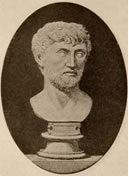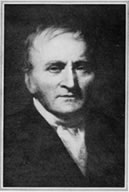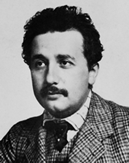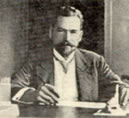Or search by topic
Number and algebra
Geometry and measure
Probability and statistics
Working mathematically
Advanced mathematics
For younger learners
Published 2011 Revised 2023
Randomness and Brownian Motion
Randomness and Brownian Motion

The Roman Poet Titus Lucretius Carus (c.99-c.55 BCE) the author of On the Nature of Things
The Roman poet and philosopher Lucretius wrote On the Nature of Things (c. 60 CE) where he described the motion of dust particles dancing in the light of a sunbeam, and attributed their motion to the invisible blows of atoms. Nowadays we might explain this by the small currents of air moving the dust, but there are other situations where we can see this happening. For example, in the school laboratory, it is possible to see this kind of motion with Lycopodium Powder [see note 1] floating on water and viewed under a microscope.
What is moving the particles of powder?

Robert Brown (1773-1858) The 'jiggling' of pollen grains he saw is now called 'Brownian Motion'
In 1827 the botanist Robert Brown noticed that if you looked at pollen grains in water through a microscope, the pollen jiggles about. He called this jiggling 'Brownian motion', but Brown couldn't understand what was causing it. He thought at first the pollen must be alive, but after testing the phenomenon with fine dust particles, he confirmed that the movement was not due to any living organism.

John Dalton (1766-1844) Often called the 'Father of Modern Chemistry'. He was the principal proponent of an atomic theory and published the first table of relative atomic weights.
In 1800, John Dalton (1766-1844), a Quaker from Cumbria became the Secretary of the Manchester Literary and Philosophical Society [see note 2]. Dalton became one of the most important chemists of his time and through his experimental work promoted the first systematic ideas of an atomic theory. As with all scientific theories, there were many people who contributed their views, and Dalton's achievements rested on those of a number of scientists from France and England [see note 3].

A portrait of Albert Einstein in 1905. During this year he was working as a clerk in the Swiss Patent Office where he produced his four famous papers on The Nature of Light, Brownian Motion, Special Relativity and Mass-Energy Equivalence [see note 4].
In 1905, Einstein became interested in the phenomenon of Brownian Motion, and in the same year he published three papers which finally came up with an explanation.
Einstein realised that the jiggling of the pollen grains seen in Brownian motion was due to molecules of water hitting the tiny pollen grains, like children randomly kicking a ball in a playground. The pollen grains were visible but the water molecules were not, which was why it looked like the pollen was bouncing around on its own.
Einstein also showed that it was possible to work out how many molecules were hitting a single pollen grain and how fast the water molecules were moving - all by looking at the pollen grains.

The Polish Physicist Marian Smoluchowski (1872-1917) In 1906 he produced the mathematical equations that described the Random Processes in Brownian Motion.
Einstein's papers together with the independent work of the Polish scientist Marian Smoluchowski (1872-1917) in 1906 brought the solution of the problem to the attention of physicists, and presented it as a way to indirectly confirm the existence of atoms and molecules.
At last scientists had made predictions about the properties of atoms that could actually be tested. The French physicist Jean Perrin (1870-1942) then used Einstein's predictions to work out the size of atoms and remove any remaining doubts about their existence.
Relative Molecule Sizes
Now think of the pollen particle you can see under the microscope swimming randomly in water.
One molecule of water is about 0.1 to 0.2 nano-metres ($10^{-9}$ metres), (a hydrogen-bonded cluster of 300 atoms has a diameter of approximately 3 nano-metres) where the pollen particle is roughly 1 micro-metre ($10^{-6}$ metres)in diameter, roughly 10,000 times larger than a water molecule. So, the pollen particle can be considered as a very large balloon constantly being pushed by water
molecules. The Brownian motion of particles in a liquid is due to the instantaneous imbalance in the force exerted by the small liquid molecules on the particle.
The Mathematics of Randomness now applies to many aspects of our everyday life, though we may not be aware of it. Not only to the movement of atoms, but also to anything that has irregular movement or irregular appearance like the stock market, the identification of images, analysis of fingerprints, testing forgery of paintings and other art objects, tracking animals, gambling, gene mutation, signal communication, computer simulations, the list goes on. It is one of the exciting things about being a mathematician that the same piece of mathematics can get modified and applied to some of the most unexpected aspects of our lives.
Notes
-
Lycopodium powder is a fine yellow powder derived from the spores of Lycopodium clavatum (stag's horn club moss, running ground pine).
-
In the later 18th Century, a number of 'Literary and Philosophical' societies existed in England to promote literacy and technical education for working people, and to develop new industrial processes.
-
In particular, Joseph Priestly (1733-1804) in England, and Antoine Lavoisier (1743-2794), and Joseph Luis Gay-Lusac (1778-1850) in France.
- $E =mc^2$
References
Weblinks
Related Collections
You may also like
Divided Differences
When in 1821 Charles Babbage invented the `Difference Engine' it was intended to take over the work of making mathematical tables by the techniques described in this article.
History of Morse
This short article gives an outline of the origins of Morse code and its inventor and how the frequency of letters is reflected in the code they were given.

